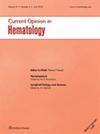Splenic filtration of red blood cells in physiology, malaria and sickle cell disease.
IF 2.9
3区 医学
Q2 HEMATOLOGY
引用次数: 0
Abstract
PURPOSE OF REVIEW The human spleen clears the blood from circulating microorganisms and red blood cells (RBCs) displaying alterations. This review analyzes how generic mechanisms by which the spleen senses RBC, such pitting, trapping and erythrophagocytosis, impact the pathogenesis of twos major spleen-related diseases, malaria and sickle cell disease (SCD). RECENT FINDINGS Scintigraphy, functional histology, comparison of circulating and splenic RBC, ex-vivo perfusion of human spleens and in-silico modeling enable relevant exploration of how the spleen retains and processes RBC in health and disease. Iterative cross-validations between medical observations, in-vitro experiments and in-silico modeling point to mechanical sensing of RBC as a central event in both conditions. Spleen congestion is a common pathogenic process explaining anemia and splenomegaly, the latter carrying a risk of severe complications such as acute splenic sequestration crisis and hypersplenism in SCD. Sickling of hemoglobin S-containing RBC may contribute but not trigger these complications. SUMMARY Ongoing progress in the exploration and understanding of spleen-related complications in malaria and SCD open the way to optimized prognosis evaluation and therapeutic applications.生理学、疟疾和镰状细胞病中红细胞的脾过滤。
综述目的 人体脾脏清除血液中的循环微生物和显示改变的红细胞(RBC)。本综述分析了脾脏感知红细胞的一般机制(如点蚀、捕获和红细胞吞噬)如何影响两种主要脾脏相关疾病--疟疾和镰状细胞病(SCD)--的发病机制。医学观察、体外实验和实验室内建模之间的迭代交叉验证表明,RBC 的机械传感是这两种情况下的中心事件。脾脏充血是解释贫血和脾脏肿大的常见致病过程,后者有导致严重并发症的风险,如急性脾疝危机和 SCD 脾功能亢进。含血红蛋白 S 的 RBC 镰状结节可能会导致这些并发症,但不会引发这些并发症。摘要在探索和了解疟疾和 SCD 脾脏相关并发症方面不断取得进展,为优化预后评估和治疗应用开辟了道路。
本文章由计算机程序翻译,如有差异,请以英文原文为准。
求助全文
约1分钟内获得全文
求助全文
来源期刊
CiteScore
6.60
自引率
3.10%
发文量
78
审稿时长
6-12 weeks
期刊介绍:
Current Opinion in Hematology is an easy-to-digest bimonthly journal covering the most interesting and important advances in the field of hematology. Its hand-picked selection of editors ensure the highest quality selection of unbiased review articles on themes from nine key subject areas, including myeloid biology, Vascular biology, hematopoiesis and erythroid system and its diseases.

 求助内容:
求助内容: 应助结果提醒方式:
应助结果提醒方式:


